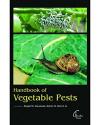
现货Handbook of Vegetable Pests[9781682511879]
¥ 1602 九五品
仅1件
上海宝山
认证卖家担保交易快速发货售后保障
作者Regina W. Mwanauta, Kelvin M. Mtei et al.
出版社Intelliz Press LLC
ISBN9781682511879
出版时间2016-01
装帧精装
纸张其他
正文语种英语
上书时间2023-08-08
- 最新上架
商品详情
- 品相描述:九五品
- 商品描述
- Garden pests plague everyone who has ever raised vegetables, from backyard gardener to professional horticulturists, farm managers, and agrobusiness professionals. The economic impacts of vegetable pests are enormous. To manage and minimize the adverse impacts of pests, it is important to identify exactly which pests are afflicting crops. The text Handbook of Vegetable Pests provides the basics of vegetable pests. The aim of first chapter is to report the most common insects’ pests which attack common bean in the field and explore the potential of agronomic, biological and botanical methods as a low-cost, safe and environmentally friendly means of controlling insect pests in legumes. The purpose of second chapter is to deliver applied research on high priority pests of glasshouse tomato and pepper crops in order to confirm relative efficacy of standard conventional chemical pesticides. Third chapter provides a foundation to understanding the influence of eco-friendly nets (EFN) and floating row covers (FRC) in pest management and tomato performance. The goal of fourth chapter is to provide a robust conclusion on the utility of ground cover in olive orchards as well as to tease-apart the relative importance of other unmeasured effects over a range of scales. The objective of fifth chapter is to assess the effect of EFN covering on cabbage seed germination, seedling physiology, insect pest population and seedling growth and quality. Biologically based methods for pest management in agriculture under changing climates have been presented in sixth chapter. The aim of seventh chapter is to assess the effect of the plant priming inducer Hx on the Bt insecticidal activity against CPB larvae fed on three solanaceous plants. Eighth chapter evaluates the resistance of grafting of tomato in its wild relative S. lycopersicum var. cerasiforme of the region of Jiquilpan, with emphasis on the tomato psyllid B. cockerelli. Ninth chapter discusses on pest management strategies for potato insect pests in the pacific northwest of the United States. Management of tuta absoluta (lepidoptera, gelechiidae) with insecticides on tomatoes has been focused in tenth chapter. Eleventh chapter focuses on global genetic differentiation in a cosmopolitan pest of stored beans. The potential use of a Serpin from arabidopsis for pest control has been discussed in twelfth chapter. Eco-friendly pest control in cucumber field with botanical pesticides has been described in thirteenth chapter. Fourteenth chapter focuses on biocide plants as a sustainable tool for the control of pests and pathogens in vegetable cropping systems. In fifteenth chapter, we discuss on small-scale tomato cultivators’ perception on pesticides usage and practices in Buea, Cameroon. Sixteenth chapter determines farmers’ perceptions of importance of sweet potato insect pests and their distribution. In seventeenth chapter, the residual pesticide levels have been determined in eggplants; purchased from four different markets in Dhaka, Bangladesh. Eighteenth chapter reviews developments in integrated management of insect pests, of parasitic broomrape plants, of the main disease-causing fungi, and of root-lesion and stem nematodes on chickpea. Exploitation of egg parasitoids for control of potential pests in vegetable ecosystems has been outlined in nineteenth chapter. The application of insecticides through a drip, or trickle, irrigation system has been introduced in last chapter.
— 没有更多了 —
![现货Handbook of Vegetable Pests[9781682511879]](https://www0.kfzimg.com/sw/kfz-cos/message/17733071/a847728786628479_b.jpg)

![现货Materials and Technologies of Modern Production[9783036401683]](https://www0.kfzimg.com/sw/kfz-cos/kfzimg/17733071/5fd2824531e165d7_s.jpg)
![现货Introduction to Container Ship Operations and Onboard Safety[9781032155425]](https://www0.kfzimg.com/sw/kfz-cos/kfzimg/17733071/58b7ff43ef7909ee_s.jpg)
![现货Electrophosphorescent Materials and Devices[9789814877343]](https://www0.kfzimg.com/sw/kfz-cos/kfzimg/17733071/18cc1d77bcb7b488_s.jpg)
![现货Organic Semiconductors for Optoelectronics[9781119146100]](https://www0.kfzimg.com/sw/kfz-cos/kfzimg/17733071/24c85a750c708964_s.jpg)
![现货Advances in Food Rheology and Its Applications[9780081004319]](https://www0.kfzimg.com/sw/kfz-cos/kfzimg/17733071/e0c11603c9119d4d_s.jpg)
![现货Advanced Materials and Sustainable Technologies[9783035727562]](https://www0.kfzimg.com/sw/kfz-cos/kfzimg/17733071/dced675333874c48_s.jpg)
![现货Advanced Materials and Manufacturing Engineering II[9783035712681]](https://www0.kfzimg.com/sw/kfz-cos/kfzimg/17733071/660ccfae75fa8d3e_s.jpg)
![现货Materials in Machinery and Construction[9783035718119]](https://www0.kfzimg.com/sw/kfz-cos/kfzimg/17733071/6f402060775e9daa_s.jpg)
![现货Cereal Grain Quality (Softcover Reprint of the Original 1st 1996)[9789401071772]](https://www0.kfzimg.com/sw/kfz-cos/kfzimg/17733071/f93ca1c96a97403a_s.jpg)
![现货Handbook of Vegetable Pests[9781682511879]](/dist/img/error.jpg)
以下为对购买帮助不大的评价